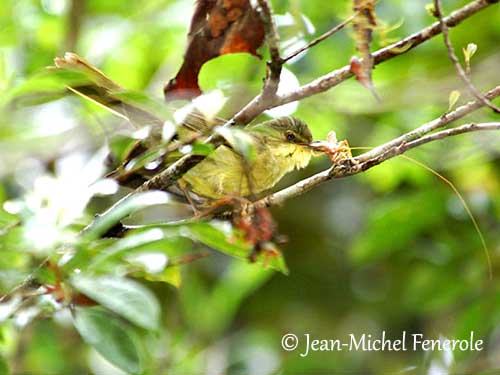
PROTECTION / THREATS / STATUS:
The Long-billed Bernieria is usually common throughout the range, but less common in SW of the island.
The species is restricted to primary habitats and adjacent secondary growths, but it is present in several protected areas.
As it depends on forests, it is vulnerable to forest destruction but the species is not globally threatened and currently evaluated as Least Concern.
Fr: Bulbul tétraka
Ang: Long-billed Bernieria - Long-billed Tetraka - Long-billed Greenbul
All: Gmelinbülbül
Esp: Bulbul Tetraka
Ita: Bulverde beccolungo
Nd: Bernieria
Sd: långnäbbad madagaskarsångare
Mal: Droadroaka, marotaina, Tekitekiala, Tetraka, Toaiky
Photographers:
Patrick Ingremeau
TAMANDUA
Jean Michel Fenerole
Photos d’Oiseaux du monde
Philip Stapelberg
GALLERY
Text by Nicole Bouglouan
Sources:
HANDBOOK OF THE BIRDS OF THE WORLD Vol 10 by Josep del Hoyo-Andrew Elliott-David Christie - Lynx Edicions - ISBN: 8487334725
Birds of Madagascar and the Indian Ocean Islands Par Roger Safford, Adrian Skerrett, Frank Hawkins – ISBN: 1472924118, 9781472924117- Editeur: Bloomsbury Publishing, 2015
The Birds of Africa: Volume VIII: The Malagasy Region: Madagascar, Seychelles, Comoros, Mascarenes - Par Roger Safford, Frank Hawkins – ISBN: 1408190494, 9781408190494- Editeur: A&C Black, 2013
Wildlife of Madagascar par Ken Behrens,Keith Barnes - ISBN: 140088067X, 9781400880676 – Editeur: Princeton University Press, 2016
CREAGUS - MALAGASY WARBLERS Bernieridae
Fatbirder - Bernieridae - Malagasy Warblers
Wikipedia, the free encyclopaedia
Long-billed Bernieria (or Tetraka)
Bernieria madagascariensis
Passeriformes Order – Bernieridae Family
INTRODUCTION:
The Long-billed Bernieria is endemic to Madagascar. It is found in N, W, and E of the island, and it heavily depends on forests, both evergreen and dry deciduous forests. Two subspecies share the distribution and are widespread throughout the range.
This long-billed, robust passerine is often active and noisy while foraging in dense vegetation, gleaning from branches and leaves or clinging to vertical trunks. It feeds on a wide variety of arthropods and also consumes plant seeds. It is gregarious and often joins mixed-species flocks.
The Long-billed Bernieria is not globally threatened, but it is vulnerable to forest destruction.
DESCRIPTION OF THE BIRD:
Biometrics:
Length: 17-20 cm
Weight: M: 22-39 g – F: 20-31 g
The Long-billed Bernieria has dark brownish-green head, upperparts and uppertail, but the wings are slightly darker with brown flight-feathers showing fine yellowish edges.
On the underparts, chin and throat are yellow, whereas centre of breast and upper belly are duller to white. Rest of underparts is olive-green with paler underwings.
On the head, the crown is dark brownish-green. Lores, cheeks and ear-coverts are duller. We can see an indistinct, darker eye stripe and a narrow, pale olive-yellow supercilium, sharper in front of eye. The ear-coverts are finely streaked with olive-yellow.
The long bill has dark grey-brown upper mandible with slightly hooked tip. The lower mandible is paler with pale pinkish base, and is slightly inflated centrally and towards the tip. The eyes are chestnut to mid-brown. Legs and feet are brown to greyish-brown.
Male and female have similar plumage, but the female is slightly smaller with shorter bill.
The juvenile resembles adult but it is duller and browner above with more indistinct eye stripe and supercilium. The underparts are duller, less yellow. The bill is paler and shorter.

SUBSPECIES AND RANGE:
The Long-billed Bernieria has two subspecies.
B.m. incelebris is found in N and W Madagascar, including Nosy Be. This race has paler and greyer upperparts.
B.m. madagascariensis is found in E Madagascar, including Sainte Marie Island.
HABITAT:
The Long-billed Bernieria of nominate race frequents the eastern primary humid forest and can be seen in adjacent secondary vegetation up to 1,300 metres of elevation.
The race “incelebris” frequents the dry deciduous forests in N and NW. However, it is absent from the spiny forest in SW. It can be seen from sea-level to 1,000 metres of elevation.
CALLS AND SONGS: SOUNDS BY XENO-CANTO
The Long-billed Bernieria gives a short, repeated “chep” and a short rattle “brrrt” as contact call. The alarm call is a dry “chack”.
The song given from concealed perch is a series of melodious whistles “chee tee tee tee” becoming quieter towards the end. It usually follows some “tchip” notes.
The W population has low, simple, variable, fluting song.
BEHAVIOUR IN THE WILD:
The Long-billed Bernieria feeds mainly on arthropods such as Coleoptera, Blattodea, Hymenoptera, Hemiptera, orthopterans, lepidopterans and spiders. It also consumes some plant seeds and small geckos.
It sometimes forages in tree tops, and generally between 1 and 20 metres above the ground. It picks prey from bark crevices and epiphytes, or gleans from branches and leaves and creeps to vertical trunks. It also searches for prey in shallow cavities, fallen trees, palm fronds and in the leaf-litter on the ground. It may sometimes catch flying insects by flycatching.

It often feeds in mixed-species foraging flocks, and sometimes in family groups within the flocks. It can be seen alone too.
The Long-billed Bernieria is often aggressive. The birds are observed facing conspecifics with open wings and calling at each other. Physical fights may occur with pecks to wings and tail, both perched and in flight.
It sings mainly between September and February, indicating the breeding period.
This species is probably sedentary on the island.
It usually flies only over short distances.
REPRODUCTION OF THIS SPECIES:
The breeding behaviour of this species is poorly known. Birds in breeding conditions can be seen in November, with the male singing in September/February.
The nest is a hanging cup suspended between twigs. It is made with plant fibres and covered with moss on the outer part. It is placed 1-2 metres above the ground. One nest was in a Helichrysum shrub.
The female lays 1-2 white eggs with dark speckles. Dependent young was seen in December, and immatures in September. No more information.
